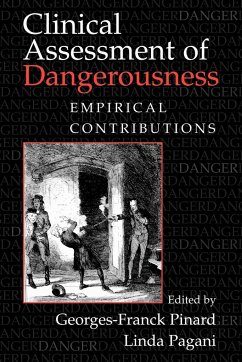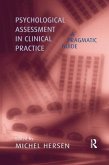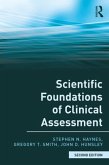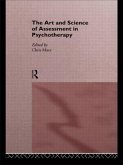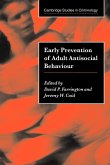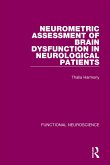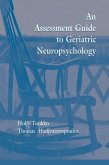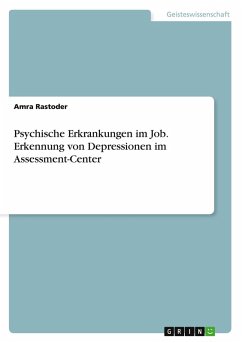Clinical Assessment of Dangerousness
Empirical Contributions
Herausgeber: Pinard, Georges-Franck; Georges-Franck, Pinard; Pagani, Linda
Clinical Assessment of Dangerousness
Empirical Contributions
Herausgeber: Pinard, Georges-Franck; Georges-Franck, Pinard; Pagani, Linda
- Broschiertes Buch
- Merkliste
- Auf die Merkliste
- Bewerten Bewerten
- Teilen
- Produkt teilen
- Produkterinnerung
- Produkterinnerung
An effective guide to help clinicians make sound decisions concerning the dangerousness of their clients.
Andere Kunden interessierten sich auch für
![Psychological Assessment in Clinical Practice Psychological Assessment in Clinical Practice]() Psychological Assessment in Clinical Practice65,99 €
Psychological Assessment in Clinical Practice65,99 €![Scientific Foundations of Clinical Assessment Scientific Foundations of Clinical Assessment]() Stephen N. HaynesScientific Foundations of Clinical Assessment61,99 €
Stephen N. HaynesScientific Foundations of Clinical Assessment61,99 €![The Art and Science of Assessment in Psychotherapy The Art and Science of Assessment in Psychotherapy]() Chris Mace (ed.)The Art and Science of Assessment in Psychotherapy59,99 €
Chris Mace (ed.)The Art and Science of Assessment in Psychotherapy59,99 €![Early Prevention of Adult Antisocial Behaviour Early Prevention of Adult Antisocial Behaviour]() David P. Farrington / Jeremy W. Coid (eds.)Early Prevention of Adult Antisocial Behaviour65,99 €
David P. Farrington / Jeremy W. Coid (eds.)Early Prevention of Adult Antisocial Behaviour65,99 €![Neurometric Assessment of Brain Dysfunction in Neurological Patients Neurometric Assessment of Brain Dysfunction in Neurological Patients]() Thalia HarmonyNeurometric Assessment of Brain Dysfunction in Neurological Patients62,99 €
Thalia HarmonyNeurometric Assessment of Brain Dysfunction in Neurological Patients62,99 €![An Assessment Guide To Geriatric Neuropsychology An Assessment Guide To Geriatric Neuropsychology]() Holly TuokkoAn Assessment Guide To Geriatric Neuropsychology74,99 €
Holly TuokkoAn Assessment Guide To Geriatric Neuropsychology74,99 €![Psychische Erkrankungen im Job. Erkennung von Depressionen im Assessment-Center Psychische Erkrankungen im Job. Erkennung von Depressionen im Assessment-Center]() Amra RastoderPsychische Erkrankungen im Job. Erkennung von Depressionen im Assessment-Center15,95 €
Amra RastoderPsychische Erkrankungen im Job. Erkennung von Depressionen im Assessment-Center15,95 €-
-
-
An effective guide to help clinicians make sound decisions concerning the dangerousness of their clients.
Produktdetails
- Produktdetails
- Verlag: Cambridge University Press
- Seitenzahl: 304
- Erscheinungstermin: 31. Oktober 2009
- Englisch
- Abmessung: 229mm x 152mm x 18mm
- Gewicht: 496g
- ISBN-13: 9780521127004
- ISBN-10: 0521127009
- Artikelnr.: 27986572
- Herstellerkennzeichnung
- Libri GmbH
- Europaallee 1
- 36244 Bad Hersfeld
- gpsr@libri.de
- Verlag: Cambridge University Press
- Seitenzahl: 304
- Erscheinungstermin: 31. Oktober 2009
- Englisch
- Abmessung: 229mm x 152mm x 18mm
- Gewicht: 496g
- ISBN-13: 9780521127004
- ISBN-10: 0521127009
- Artikelnr.: 27986572
- Herstellerkennzeichnung
- Libri GmbH
- Europaallee 1
- 36244 Bad Hersfeld
- gpsr@libri.de
Contributors; Prologue Paul S. Appelbaum; Part I. Introduction: 1. Clinical
assessment of dangerousness: an overview of the literature Linda Pagani and
Georges-F. Pinard; Part II. Basic Issues in Violence Research: 2. Biology,
development, and dangerousness Elizabeth J. Susman and Jordan W.
Finkelstein; 3. The development of physical aggression during childhood and
the prediction of later dangerousness Richard E. Tremblay; 4. Predicting
adult official and self-reported violence David P. Farrington; Part III.
Mental Health Issues and Dangerousness: 5. Major mental disorder and
violence: epidemiology and risk assessment John Monahan; 6. Axis II
disorders and dangerousness Kenneth Tardiff; 7. Recidivistic violent
behaviour and axis I and II disorders Jari Tiihonen; Part IV. Family Issues
and Dangerousness: 8. Risk assessment for intimate partner homicide
Jacquelyn C. Campbell, Phyllis Sharps and Nancy Glass; 9. Parents at risk
of filicide Maureen Marks; 10. Parricide Charles P. Ewing; Part V.
Individual Characteristics and Dangerousness: 11. Alcohol and dangerousness
Joan McCord; 12. Violence and substance abuse Philip Bean; 13. Threats,
stalking and criminal harassment J. Reid Meloy; Part VI. Conclusion: 14.
Discussion and clinical commentary on issues in the assessment and
prediction of dangerousness Georges-F. Pinard and Linda Pagani; Index.
assessment of dangerousness: an overview of the literature Linda Pagani and
Georges-F. Pinard; Part II. Basic Issues in Violence Research: 2. Biology,
development, and dangerousness Elizabeth J. Susman and Jordan W.
Finkelstein; 3. The development of physical aggression during childhood and
the prediction of later dangerousness Richard E. Tremblay; 4. Predicting
adult official and self-reported violence David P. Farrington; Part III.
Mental Health Issues and Dangerousness: 5. Major mental disorder and
violence: epidemiology and risk assessment John Monahan; 6. Axis II
disorders and dangerousness Kenneth Tardiff; 7. Recidivistic violent
behaviour and axis I and II disorders Jari Tiihonen; Part IV. Family Issues
and Dangerousness: 8. Risk assessment for intimate partner homicide
Jacquelyn C. Campbell, Phyllis Sharps and Nancy Glass; 9. Parents at risk
of filicide Maureen Marks; 10. Parricide Charles P. Ewing; Part V.
Individual Characteristics and Dangerousness: 11. Alcohol and dangerousness
Joan McCord; 12. Violence and substance abuse Philip Bean; 13. Threats,
stalking and criminal harassment J. Reid Meloy; Part VI. Conclusion: 14.
Discussion and clinical commentary on issues in the assessment and
prediction of dangerousness Georges-F. Pinard and Linda Pagani; Index.
Contributors; Prologue Paul S. Appelbaum; Part I. Introduction: 1. Clinical
assessment of dangerousness: an overview of the literature Linda Pagani and
Georges-F. Pinard; Part II. Basic Issues in Violence Research: 2. Biology,
development, and dangerousness Elizabeth J. Susman and Jordan W.
Finkelstein; 3. The development of physical aggression during childhood and
the prediction of later dangerousness Richard E. Tremblay; 4. Predicting
adult official and self-reported violence David P. Farrington; Part III.
Mental Health Issues and Dangerousness: 5. Major mental disorder and
violence: epidemiology and risk assessment John Monahan; 6. Axis II
disorders and dangerousness Kenneth Tardiff; 7. Recidivistic violent
behaviour and axis I and II disorders Jari Tiihonen; Part IV. Family Issues
and Dangerousness: 8. Risk assessment for intimate partner homicide
Jacquelyn C. Campbell, Phyllis Sharps and Nancy Glass; 9. Parents at risk
of filicide Maureen Marks; 10. Parricide Charles P. Ewing; Part V.
Individual Characteristics and Dangerousness: 11. Alcohol and dangerousness
Joan McCord; 12. Violence and substance abuse Philip Bean; 13. Threats,
stalking and criminal harassment J. Reid Meloy; Part VI. Conclusion: 14.
Discussion and clinical commentary on issues in the assessment and
prediction of dangerousness Georges-F. Pinard and Linda Pagani; Index.
assessment of dangerousness: an overview of the literature Linda Pagani and
Georges-F. Pinard; Part II. Basic Issues in Violence Research: 2. Biology,
development, and dangerousness Elizabeth J. Susman and Jordan W.
Finkelstein; 3. The development of physical aggression during childhood and
the prediction of later dangerousness Richard E. Tremblay; 4. Predicting
adult official and self-reported violence David P. Farrington; Part III.
Mental Health Issues and Dangerousness: 5. Major mental disorder and
violence: epidemiology and risk assessment John Monahan; 6. Axis II
disorders and dangerousness Kenneth Tardiff; 7. Recidivistic violent
behaviour and axis I and II disorders Jari Tiihonen; Part IV. Family Issues
and Dangerousness: 8. Risk assessment for intimate partner homicide
Jacquelyn C. Campbell, Phyllis Sharps and Nancy Glass; 9. Parents at risk
of filicide Maureen Marks; 10. Parricide Charles P. Ewing; Part V.
Individual Characteristics and Dangerousness: 11. Alcohol and dangerousness
Joan McCord; 12. Violence and substance abuse Philip Bean; 13. Threats,
stalking and criminal harassment J. Reid Meloy; Part VI. Conclusion: 14.
Discussion and clinical commentary on issues in the assessment and
prediction of dangerousness Georges-F. Pinard and Linda Pagani; Index.

